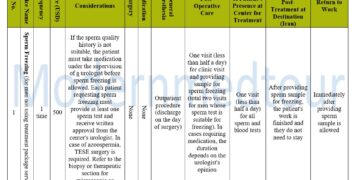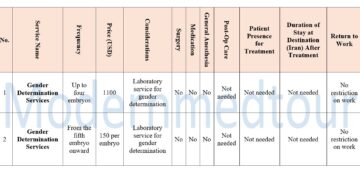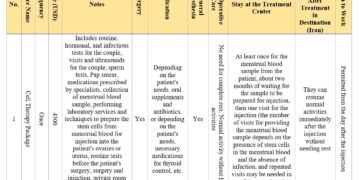Corneal transplantation in Iran: its types and definitions to shed light on modern transplantation techniques
the introduction:
Corneal transplantation is a vital surgical procedure aimed at replacing an injured or damaged cornea with a healthy one, with the aim of restoring vision and improving quality of life. Corneal transplantation varies in types and techniques, and in this article, we will review the types of corneal transplantation and their definitions in some detail.
Types of corneal transplant:
1. **Complete corneal transplantation (PKP – Penetrating Keratoplasty):**
– It involves replacing all layers of the cornea with a whole new cornea from a donor. It is used in cases of extensive corneal damage or structural abnormalities.
2. **Anterior Lamellar Keratoplasty:**
– Only the front layer of the cornea is replaced, without affecting the remaining layers. Used in cases of damage to the surface paint layer.
3. **Posterior corneal transplantation (DALK – Deep Anterior Lamellar Keratoplasty):**
– The front and central parts of the cornea are replaced, while the back layers are preserved. It is used when the posterior layers of the cornea are healthy.
4. **Autokeratoplasty:**
A portion of the cornea is taken from the same patient and transplanted into another area on the same cornea. It is used in cases of correction of specific deformities.
5. **Frozen Cornea Transplantation:**
The donor cornea is frozen and used later in transplantation, which enhances the preservation of corneal quality and delays transplantation.
Definitions of corneal transplant:
1. **Keratoplasty:**
– It is a surgical procedure that involves replacing the cornea with another from another source, whether from a living donor or another area in the same body.
2. **Epithelium:**
It is the outer layer of the cornea, and its transplantation may be necessary in cases of damage to the surface layer as a result of injuries or diseases.
3. **Anterior cornea:**
It is the front and transparent part of the cornea, and its transplantation is used in anterior transplantation procedures.
4. **Posterior cornea:**
– These are the thickest layers of the cornea, and may be preserved in some types of corneal transplants to maintain structural stability.
5. **Autokeratoplasty:**
It is a type of corneal transplant in which a person uses a piece of his own cornea for the transplant, which reduces the risk of the body rejecting the transplant.
6. **Donor:**
– He is the person who provides the cornea to be transplanted into the body of another person.
Conclusion:
Corneal transplantation remains a modern and effective technology in restoring vision and improving people’s quality of life. Doctors and researchers are striving to develop more advanced techniques to ensure successful operations and improve the chances of fully restoring vision.
Corneal transplantation in Iran: Center for care and modern technologies
the introduction:
Iran is considered one of the world’s leading destinations in the field of corneal transplantation, providing high-quality healthcare and modern technologies to individuals who need a corneal transplant. The advanced medical environment and technological development in Iran offers excellent opportunities for patients seeking to restore vision and improve their quality of life. In this article, we will review the reasons why corneal transplantation in Iran is an excellent option.
Outstanding medical care:
Iran is proud to provide high-level health care, where a qualified and specialized medical team works to provide comprehensive care to patients. This care includes a comprehensive assessment of the health condition and careful visual evaluation to determine the need for a corneal transplant and determine the appropriate method of treatment.
modern techniques:
The success of corneal transplant operations depends on the techniques used, and in Iran the latest medical technologies and equipment are used. This includes different transplant techniques such as whole corneal transplantation and anterior and posterior corneal transplantation, which contributes to meeting the needs of different patient conditions.
Suitable cost:
The cost of corneal transplantation in Iran is reasonable compared to some other countries, making it a potential destination for patients looking for high quality at an affordable cost. Favorable economic aspects attract more international patients to this destination.
Effective language translation:
One of the big advantages of corneal transplantation in Iran is the provision of language translation services, which facilitates communication between doctors and international patients. This helps in accurately understanding the diagnosis and treatment options.
Excellent success record:
Iran has an excellent success record in corneal transplantation, which indicates the skill of the medical teams and dedication to providing superior medical care. Advanced implant techniques contribute to achieving excellent results and improving the quality of vision.
Medical infrastructure:
Iran has an advanced medical infrastructure, with medical centers equipped with the latest technology and specialized medical teams. This structure contributes to providing effective and safe medical services.
Medical tourism:
Iran offers international patients the opportunity to combine treatment with a unique tourism experience. Beautiful tourist places and rich culture add value to the treatment journey and contribute to improving the patient’s experience.
In conclusion:
Corneal transplantation in Iran does not only mean restoring vision, but rather represents a comprehensive experience that includes distinguished care, modern technologies, and an affordable cost. Y
Iran’s choice of corneal transplantation was a step towards improving quality of life and achieving the best health outcomes.
Title: “Corneal Transplantation with Modern Med Tour (MMT): Luxury and Excellence in Treatment”
the introduction:
Modern Med Tour (MMT) is one of the leading medical travel facilitation companies in Iran, providing premium services to international patients seeking corneal transplants. In this article, we will review why corneal transplantation with MMT is an excellent option for patients seeking to improve their vision and enjoy the treatment experience with complete comfort and luxury.
1. **Integrated services:**
MMT offers a package of integrated services that include coordinating medical appointments, accommodation, and transportation, which helps patients focus fully on the treatment process without worrying about logistical details.
2. **Ongoing guidance and support:**
-MMT provides ongoing guidance and support to patients throughout their treatment. The specialist medical team ensures advice and assistance at every step of the journey.
3. **Modern technologies:**
– Cooperation with MMT allows patients to benefit from the latest technologies in the field of corneal transplantation. In addition, hospitals and clinics are carefully selected to ensure excellent care.
4. **Language provision:**
– Language issue is a barrier for many international patients, but with MMT translation services are provided to ensure accurate and transparent understanding of medical directions and effective communication.
5. **Personal care:**
– Special attention is paid to providing personalized care to each patient. The team works to understand each individual’s needs and ensure they are met effectively.
6. **Quality Guarantee:**
MMT is concerned with providing high-quality medical services, as medical facilities are carefully selected to ensure the use of modern medical equipment and the provision of appropriate care.
7. **Travel arrangements:**
– MMT provides travel coordination services, including ticket reservations and other logistical arrangements, making it easier for patients to travel and reach Iran with ease.
8. **Tourist experience:**
The MMT collaboration adds a tourism dimension to the treatment experience, as patients can explore the beauty and history of Iran between treatment periods.
In short, MMT provides a corneal transplant experience with a high level of luxury and excellence, where outstanding care is provided in all its aspects to ensure the success of the treatment and achieve the best health outcomes.
























